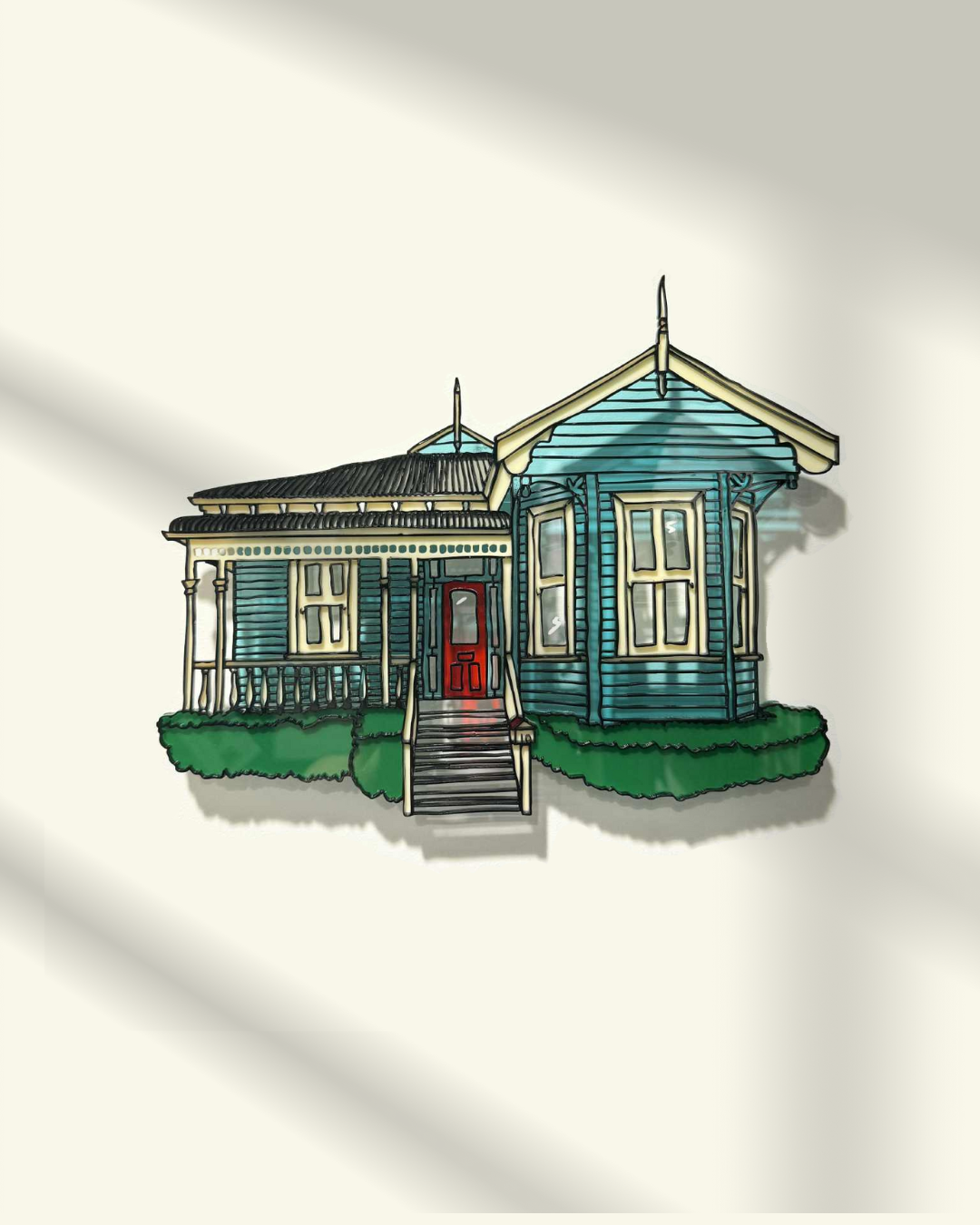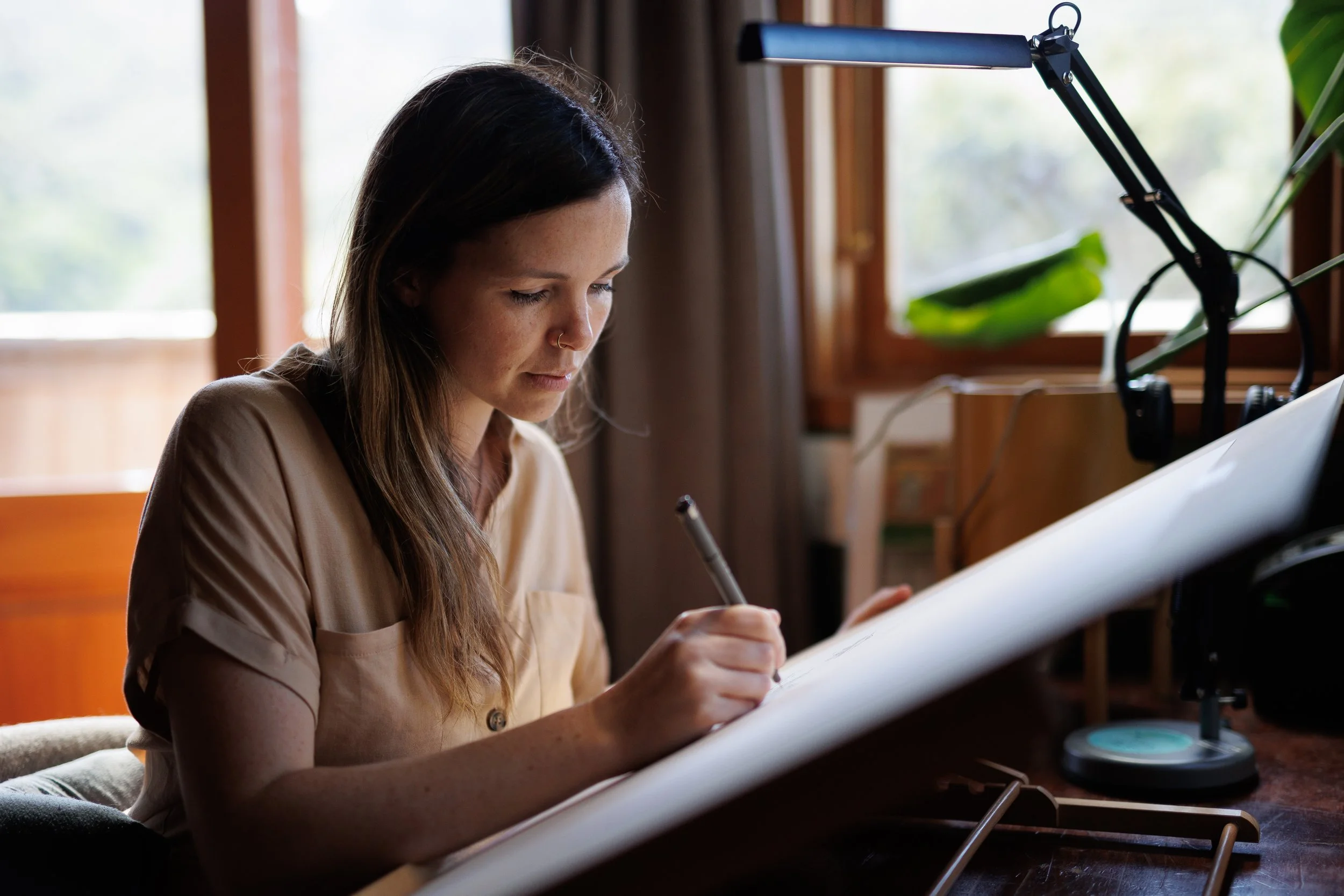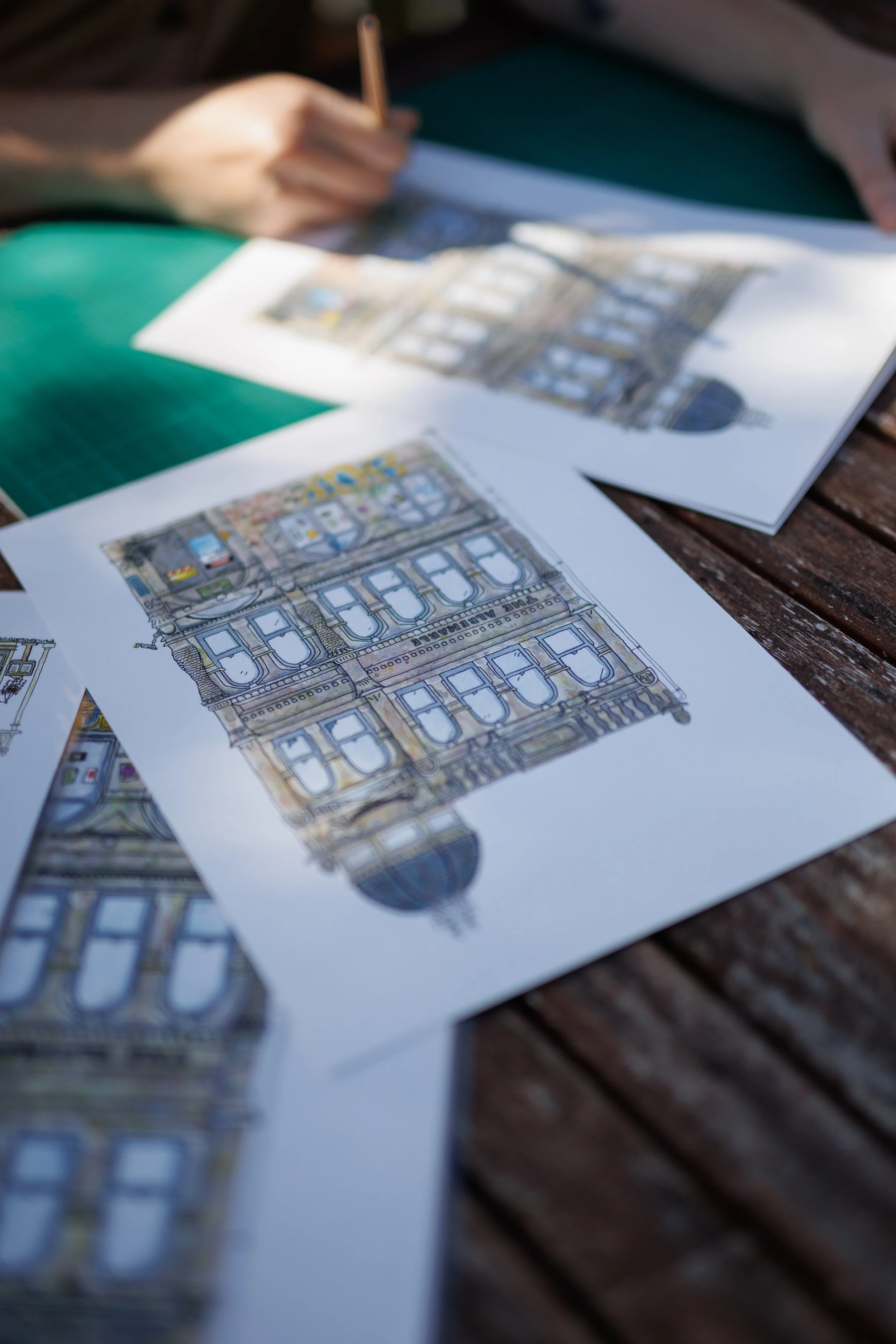Taking Care of Acrylic Sculptures
Buying a piece of delicate artwork can seem daunting - here are some tips and tricks on how to easily take your artwork home, hang it, and clean it.
Hanging and positioning
Avoid placing the sculpture in strong, prolonged, direct sunlight as this may fade the colours over time.
Hanging on wall
If you purchased a acrylic sculpture at an art show - it may have been sold with a white backing disc for display purposes. Here show to hang both with and thout the disc:
Hanging the sculpture with the white disc mount:
The disc mount has a keyhole hanger on the back. Use a flathead screw or nail that is around 35mm. The sculptures are light, so there is no need to use a drywall hanger. It should protrude 6 or 7mm away from the wall so it sits comfortably in the keyhole hanger. When lifting the mount onto the wall, keep it level and avoid tipping the sculpture forward. It's best to do this with two people if possible.
If you wish to place the sculpture directly onto a wall:
Try using white gloves when handling the sculpture to avoid leaving fingerprints and marks on the perspex.
Always handle the sculpture where there are multiple layers of acrylic, as these are the sturdiest parts.
Avoid handling delicate parts of the sculpture.
Each sculpture has one or two keyhole hangers on the back. Hold the sculpture up and mark where the screws should be placed onto your chosen wall.
I recommend using 30mm or longer screws with a flat head. Drill the screw into the wall leaving a 20mm standoff so the sculpture lies flush to the wall.
Cleaning and Care
The best way to remove dust from the sculptures is to use a can of compressed air dust remover which can be purchased at Bunnings.
Always use a microfibre cloth when wiping down the acrylic surface to avoid scratching the material.
All other marks can be removed by gently using water and a microfibre cloth.
As always, I’m here to help so if you have any questions, reach out. I can also install the artworks for you for an additional fee.
Stacey
3D Sculpture or Ink & Watercolour — How to Choose the Right Artwork for You
When you decide to commission a piece of art, it’s not just about what it looks like — it’s about how you want it to feel.
Both my Ink & Watercolour works and 3D Sculptures capture the spirit of place — but they tell that story in completely different ways. Here’s how to choose which one might be right for you.
Ink & Watercolour — for the detail lovers
If you’re drawn to delicate linework and including all the small details an Ink & Watercolour piece might be your perfect match.
These works are personal and timeless with every little details captured. They’re ideal if you:
Want a detailed, elegant artwork to treasure or gift
Have a special building or home that holds deep sentimental value
Want to include details like pets
Need a piece that fits a smaller budget
Prefer a traditional framed artwork
Each piece begins with fine ink work — drawn by hand — and layered with soft watercolours that bring it all to life.
🎨 3D Sculpture — for the bold and the curious
If you want to make a statement, my 3D Sculptures offer something truly unique.
They’re vibrant, layered, and tangible — artworks you can almost step into. These pieces are perfect if you:
Want something completely bespoke and full of personality
Have a bigger budget and want a centrepiece artwork
Love colour, dimension, and texture
Want a conversation starter for your home or business
Each sculpture is hand-drawn in the same style as my ink and watercolours then recreated in layers of acrylic perspex to create depth and vibrancy that dances with light.
💭 How to Decide
It really comes down to what you want your artwork to say.
If you want something nostalgic and detailed — go Ink & Watercolour.
If you want something bold, tactile, and full of energy — choose 3D Sculpture.
And if you’re still not sure, that’s completely fine — I’m happy to chat and help you find the right fit for your space and story.
💫 Commissions open soon — so now’s the perfect time to start dreaming.
Korero with Stacey Fraser-Allen by Rita Edited.
What do you create and tell me a little bit about your creative process…
I create detailed ink and watercolour illustrations of architectural buildings—each piece is a celebration of memories, people, and place. My work is all about capturing that feeling of home—that warm, nostalgic pull we all feel for certain buildings or streets. I start each piece by diving into the story behind the space, often drawing inspiration from old family homes, local gems, or iconic New Zealand architecture. I sketch in fine liner to get the detail just right, and then bring everything to life with watercolour—layering colour to create mood, emotion, and a real sense of belonging.
What inspires/influences you?
Home is everything to me. It’s where I live, work, and raise my family. Both my husband and I run creative businesses from our space, so it’s truly a hub of ideas and inspiration. My art is rooted in that—capturing what place means to people, whether it’s their first flat, their nana’s villa, or the street they grew up on. My love of New Zealand, its architecture, and the nostalgia it stirs all play a huge role.
And I’ve got to mention Quentin Blake—his expressive, energetic line work has stuck with me since I was a kid. There’s a looseness and personality in his illustrations that I really admire.
When you're not working on your business, what do you love?
I try to get outdoors as much as I can—Wellington’s landscape is too good not to! I love rock climbing, mountain biking, and getting outside with friends and family. It helps me reset and keeps that creative energy flowing.
Any words of inspiration for someone thinking of giving something a go (in the business sense)?
Just start. Honestly, you’ll never feel completely ready. You’ll never have all the gear, the time, or the perfect plan. But if you’ve got a spark of an idea, follow it. Build slowly, learn constantly, and invest in yourself as you grow. Confidence comes from doing—it doesn't have to be perfect to be powerful.
Why Nostalgia Matters: Bringing Warm Memories into Modern Spaces
In our fast-paced, ever-evolving world, where technology and trends shape our lives daily, it’s easy to feel disconnected from the past. Yet, a gentle pull toward nostalgia—those moments of longing for places and times that hold cherished memories—remains universal.
Nostalgia brings warmth and familiarity into our lives, it’s that ‘smushy’ feeling you get and when woven into our lives through art, it offers a grounding sense of belonging, love, and connection. For many of my clients, art becomes more than just decoration; it becomes a bridge to cherished moments, a reminder of loved ones, and a piece of the past they can hold onto. I originally got into drawing architecture because I felt such a connection to these physical places.
I have lived in 5 countries and visited about 25 countries over the last 16 years. Through my art, I’ve been able to draw many buildings from my past in an effort to capture my ‘fading’ memories - I’m only 34! but I feel like I loose more every day!
The Psychology of Nostalgia: Why It Matters
Nostalgia is a fascinating and powerful emotional experience. Psychologists describe it as a bittersweet, often sentimental feeling triggered by memories of people, places, or past experiences. These feelings of nostalgia aren’t just pleasant—they’re beneficial to our mental well-being. Studies have shown that nostalgia can increase feelings of social connectedness, lift moods, and even boost resilience. In short, reflecting on the past can help us navigate the present with a deeper sense of purpose and emotional grounding.
When we bring these elements of nostalgia into our spaces, we create little havens that tell our personal stories. A painting of the house you grew up in, a familiar coastal view, or even the little quirks of your hometown skyline can bring back memories of formative years and precious moments.
Art with nostalgic value serves as more than just a conversation starter—it acts as an emotional touchstone. Each glance brings a rush of comfort, sparking memories of people, places, or milestones that are deeply meaningful.
Art as a Lasting Legacy
For some, nostalgic art is a legacy piece, something they plan to pass down to children and grandchildren, ensuring that memories of beloved places, family homes, or meaningful landscapes live on for generations. By preserving these connections, families create a shared story that will continue to resonate, reminding future generations of their roots and the legacy that has been built.
Wrapping Up: Making Nostalgia a Part of Your World
Nostalgia in art has a unique ability to make our spaces feel complete.
It’s a powerful reminder that no matter where life takes us, we are always connected to the moments and people who shaped us. Art has the power to bring these connections into our daily lives, celebrating the joy of nostalgia in every glance, conversation, and memory.
5 Things to Consider When Commissioning a Brick and Water Painting
Say you have a special anniversary coming up and want the perfect bespoke gift!
Commissioning a piece of art is an exciting process that allows you to create something truly unique and meaningful—but I know that it can feel a bit intimidating, especially if it’s your first time.
To help you get started, here are five things to consider when commissioning one of my paintings to fill your space:
1. Think About How the Building Makes You Feel
If there’s a building you adore—whether it’s your home, a local café, or a favourite pub—take a moment to reflect on the memories tied to that place. How does it make you feel? What’s the first image that comes to mind? Is there a particular feature of the building that stands out, like its color or architecture? Think about the angle you often view it from. Are there any specific sounds, smells, or personal stories connected to it?
The more personal details you share, the better I can capture the essence of what that building means to you (or the person you’re gifting it to). Including even the smallest elements, like an inside joke or a meaningful detail, can make the painting uniquely yours.
2. Clarify Size
Clear communication is key when commissioning a painting. Consider the size and specific features you want included. For instance, is there a particular angle of the building you prefer, or certain surrounding elements that evoke the right mood? Be sure to share what absolutely must be included and what you might be flexible about.
Visual references are incredibly helpful here. If you have photos of the building, especially from your favorite perspective, please share them. If you’re unsure about the size, send me the reference images and I can recommend a size that will work best for the piece. After our discussion, I’ll provide a quote and estimated timeline, typically around 2-3 weeks for completion.
3. Consider Your Budget
If you’re unsure where to start with sizing or cost, don’t worry—I can work within a range of budgets. Commission slots are limited and often booked 3-6 months in advance, so it’s a good idea to plan ahead.
Once your slot is secured, I’ll set up a consultation via Zoom or email to discuss your vision in detail. This is a key moment to make sure we’re aligned on what you want from the piece.
4. Ask Questions Before You Begin
Before we start, it’s important to clarify any questions you might have. Will the artwork be delivered or picked up? Would you like it custom framed? What will our communication look like throughout the process?
Getting these details sorted early on ensures everything runs smoothly and there are no surprises later.
5. Understand Your Level of Involvement
As the painting progresses, I’ll share photos so you can see how it’s taking shape. You’ll have the opportunity to provide feedback, especially as the piece nears completion. If any adjustments are needed—like tweaking colors or fine-tuning specific details—I’m happy to accommodate if possible.
Once you give the green light to proceed, a 50% deposit is required to cover materials. High-quality paints and archival paper can be costly, but they ensure your piece lasts for years to come.
Final Thoughts
Commissioning a painting is a rewarding and collaborative process. It’s all about creating something one-of-a-kind, a deeply personal piece that reflects your story and memories.
By communicating openly and trusting the process, we can create a piece that immortalizes your memories and brings them to life in a way that’s uniquely yours.
Ready to commission your own special piece? Keep an eye on your emails when commission slots open up, or visit my Services Page to see examples of past works.
Mount Cook Villa - Commission from 2022
2024 Bayleys Emerging artist award
I am beyond thrilled to receive the 2024 Emerging Artist Award courtesy of Bayleys New Zealand.
Huge congratulations to all the artist and awards winners at this year’s Art in the Park.
How to care for your giclee print
General tips for handling your brick and water giclée print
Here are a few tips and tricks I’ve learnt (sometimes through disasters!) to care for giclee prints so that they can last for years to come:
Always care for giclée prints as you would an original piece of art. This means that dirt, dust, moisture, oils, adhesives, solvents, heat, and anything that could scratch, dent or crease the paper should all be avoided when you are handling your print
Try to only handle the print with clean, dry hands or get a pair of white cotton gloves (these can be found at your local art store)
The last thing you want is smudges on your print, so always use two hands to support your print at the edges; that way, you will avoid any bends, dents or creases
Keep your giclée print covered with the acid-free tissue paper until it is framed or let me handle framing for you to avoid damage
Brick and Water giclée prints are printed on German Etching 310GSM paper which is very textured - Don’t use your hands to wipe off any dust as this can also damage the surface. Instead, use a dry, clean, white lint-free cloth or a photographer’s lens-brush
Flattening your rolled-up giclée print
If you have bought a streetscape or a larger print (A2 or A1) this may come rolled in a tube and will need to be flattened to ensure successful framing:
Find a surface that is flat, smooth and hard. Clean it of any dirt and particles that might damage your print
Unpack the kraft paper tube - your print will be wrapped in acid-free tissue paper
Carefully remove the print from the postal tube by grabbing the protective acid-free tissue paper
Lay the printout, image side up, on a flat surface
With the tissue paper still covering the print’s image, on the ends and around the middle of the print, place a few clean and dry objects that are smooth, flat and heavy...books work well!
Let your giclée print relax overnight - if it still isn’t flat when you remove the books, replace them for a few more hours
Never be tempted to use an iron, or steam to flatten it - as this will damage it!
Alternatively, let me take the hassle out and frame it for you!
Cleaning your print
Never try to clean a giclée print with a damp cloth, water or solvents. Just use a clean, dry, soft, lint-free cloth or a photographer’s lens brush to gently wipe off dust
Use a white non-coloured cloth will allow you to see when the dust has been collected
To avoid staining the giclée, do not clean it with a dirty or dark-coloured cloth








